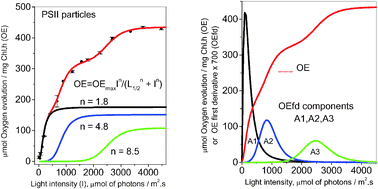In two previous papers (Fragata et al., J. Phys. Chem. B, 2005, 109, 14707–14714; Fragata et al., J. Phys. Chem. B, 2007, 111, 3315–3320), it was shown that the variation of oxygen evolution with the light intensity (I) in photosystem II (PSII) in steady state conditions can be formulated according to the Langmuir adsorption isotherm for heterogeneous catalysis. This yielded the expression OEth = OEth(max) I/(L½ + I), where OEth is the theoretical oxygen evolution, OEth(max) the maximum oxygen evolution, and L½ the irradiance giving OEth(max)/2. In this approximation, the photons interaction with the chlorophylls in the PSII reaction center is assumed to be a heterogeneous reaction in which the light is represented as a stream of particles instead of an electromagnetic wave. That is, the chlorophyll molecules are the adsorption surfaces (or heterogeneous catalysts), and the incident (or exciting) photons are the substrate, or the reagent. Recently, the examination of new experimental data obtained with 2,6-dichloro-p-benzoquinone (DCBQ) and p-benzoquinone (pBQ) as exogenous electron acceptors, disclosed the presence of oxygen evolution discontinuities (or transitions) in the light-response curves. The new data were fitted with a mathematical summation of hyperbola of order n(i) > 1, OEth = ∑i [OEth(max)]iIn(i)/[(L½)in(i) + In(i)], where the n(i)’s are the number of sites used by the incident photons in their interaction with the photosynthetic pigments in each population i of PSII centers open for photochemistry. The mathematical simulations yielded only three distinct n(i)’s, that is, 1.8, 4.8, 8.5 and 1.8, 4.2, 8.4 for isolated PSII particles incubated with DCBQ and pBQ, respectively. Implicitly, this means the simultaneous excitation of each PSII reaction center with more than one photon, that is, the excitation of more than one pigment molecule. It is suggested that these transitions have their origin in the cooperative interaction of the photons and the chlorophylls, and most likely also the pheophytins. This indicates that the discontinuities (or transitions) observed in the light-response curves of oxygen evolution are consistent with the hypothesis of photochemical cooperativity in photosystem II.


 Please wait while we load your content...
Please wait while we load your content...